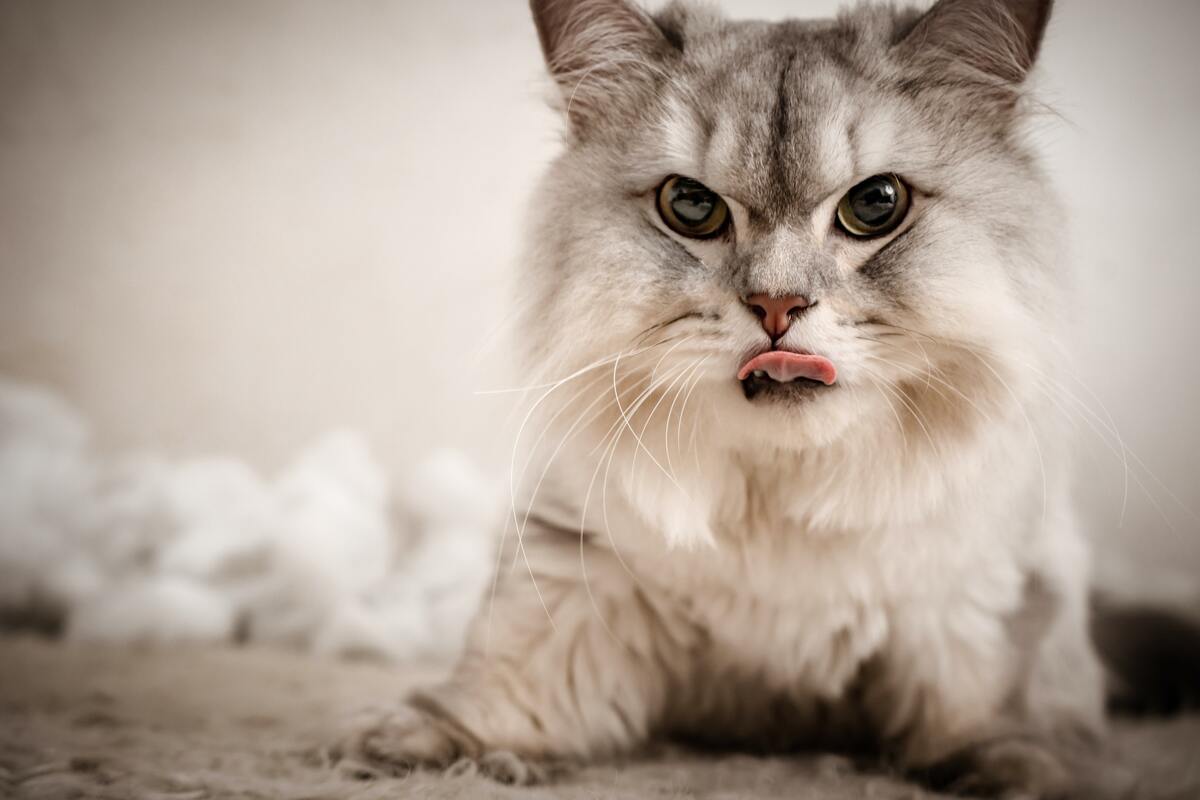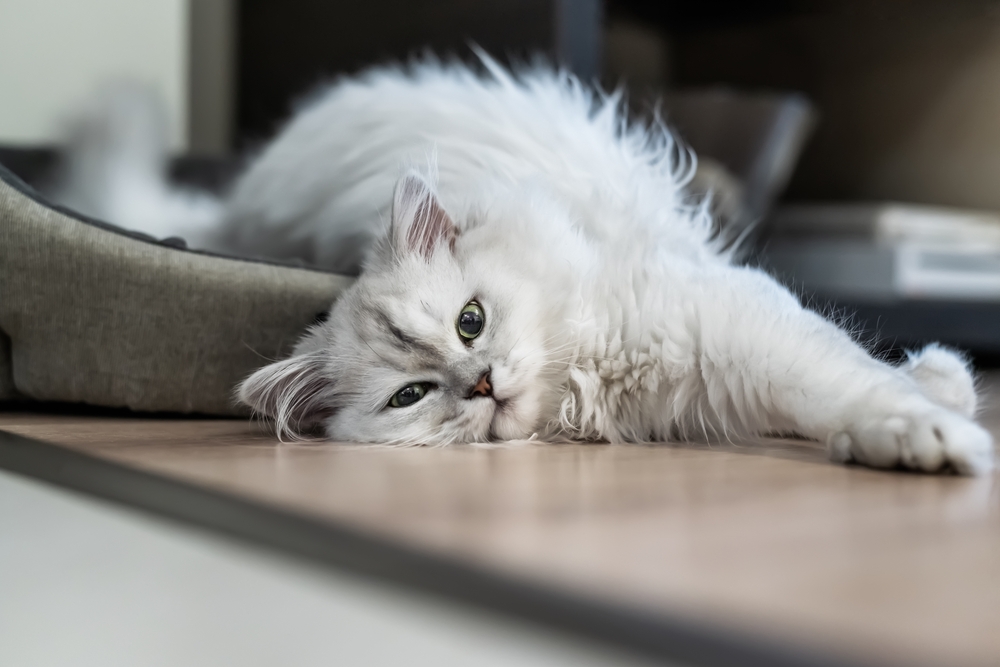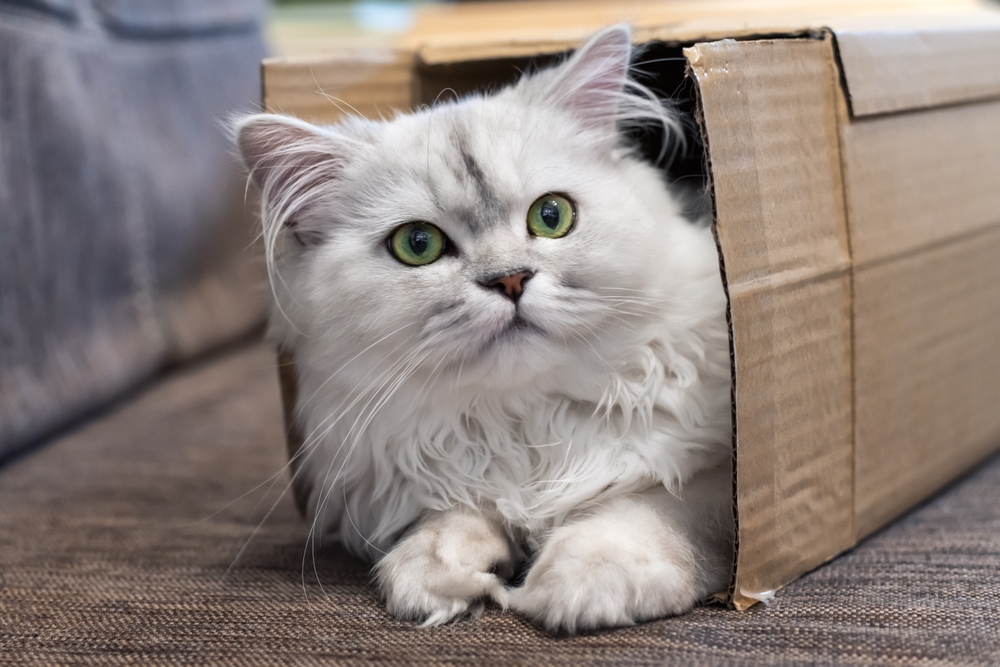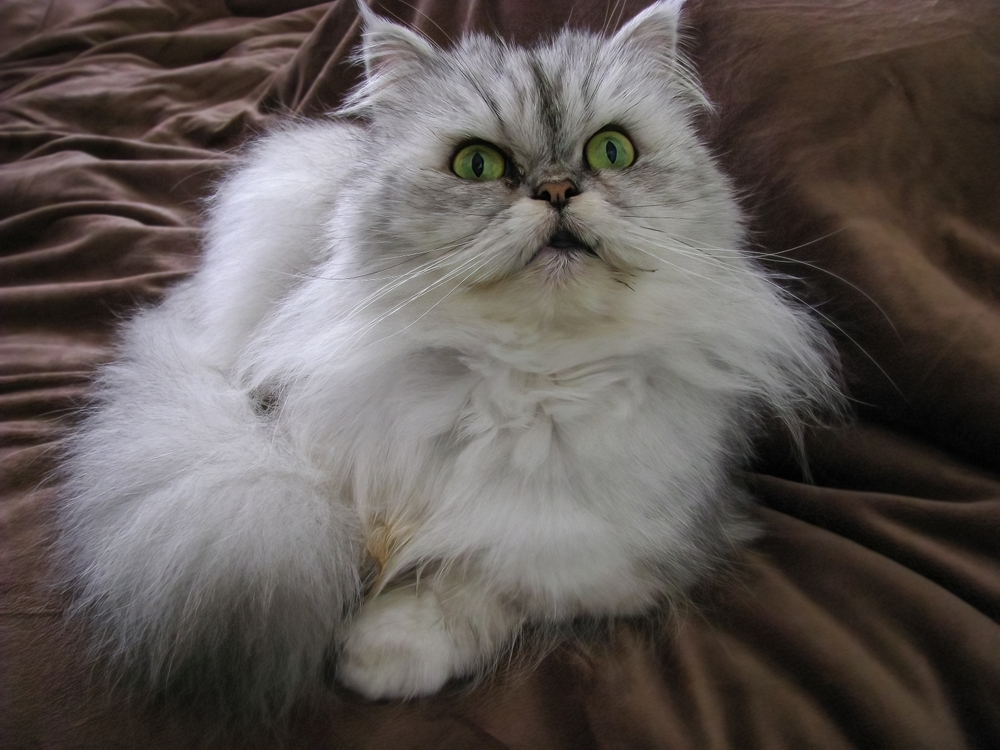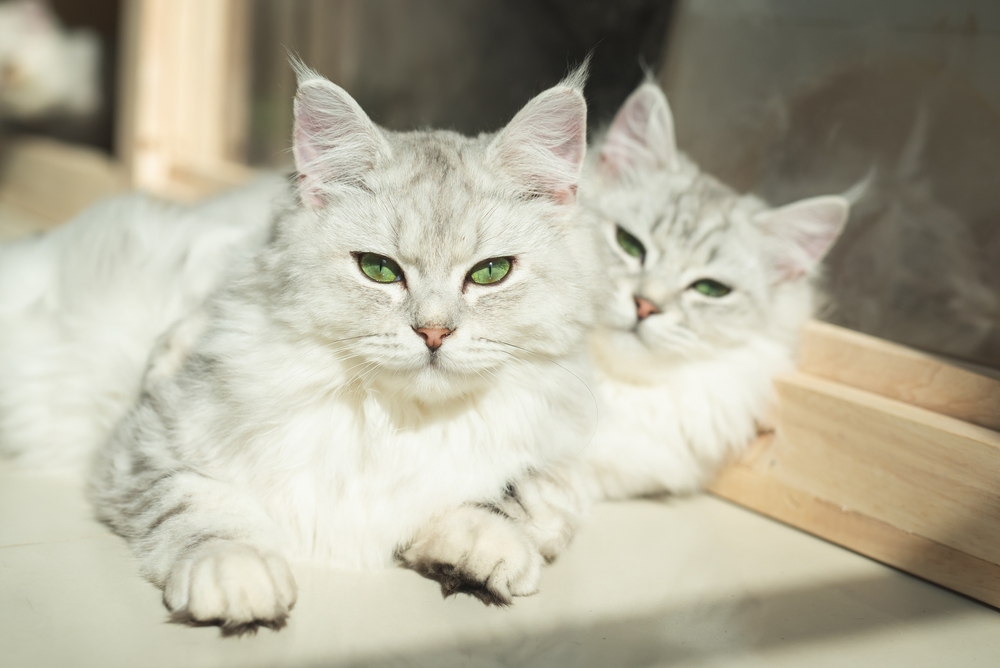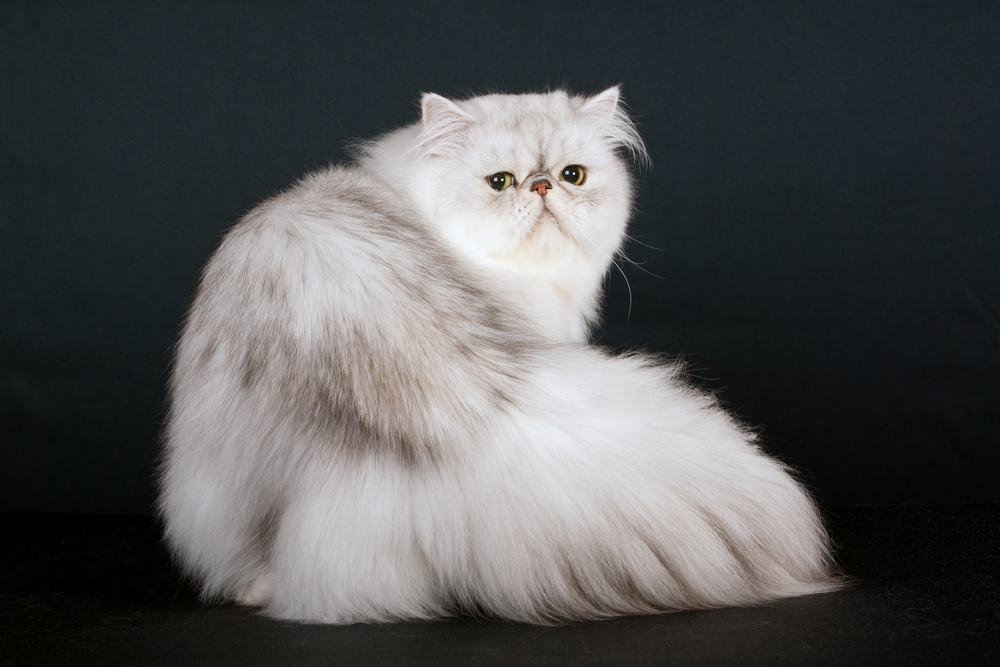📖 Table of Content:
Persian cats are one of the most popular pedigree cat breeds ever – and no, silver Persian cats aren’t grandmas and grandpas of the Persian world. Some salt-and-pepper-haired cats go gray as they age, but silver Persian cats are born with lustrous, luxurious gray locks. So, what’s the tea with silver Persians?
When you explore the wondrous world of gray cats, you might catch on to the fact that some cat breeds are exclusively gray, such as the Russian Blue, the Chartreux of France, the Korat of Thailand, and the Nebelung. Now, silver Persian cats are silver, but the breed can come in a variety of color combinations.
Whether you’re too superstitious to get a black cat or too taken aback by the upkeep that comes with owning a white cat, a silver Persian might be the right way to go. Silver Persian cats are somewhere between light silver and deep slate, but that depends on whether they’re shaded or chinchilla.
We’re going to bore you with the details below, but for now, we do want to underline that Persian cats, silver or otherwise, are one of the most accepted and adored breeds around the world. Persian cats are affectionate, sweet-tempered, and gentle, and they’re everything you need and more.
What are Persian cat colors?
Persian cats are one of the breeds that come with a variety of colors and color combinations to choose from. Before we explore the dos and don’ts of caring for a silver Persian cat, we might as well touch on the rest of the color palette, too. But we do need to mention that all Persian cat colors are accepted.
When competing, Persian cats are divided based on the color and the pattern of the coat – the seven divisions are solid, silver and golden, smoke and shaded, tabby, parti-color, bi-color, and Himalayan (or pointed).
Starting from the beginning, solid Persian cats contain one color throughout the entire coat. Common colors are white, black, blue, chocolate, cream, lilac, and red. Solid Persian cats aren’t rare, but some of the colors might be harder to come by than others (a.k.a. blue).
Silver and gold Persian cars are super, duper rare, whether they’re chinchilla or shaded pattern. Chinchilla Persian cats are white with black, gray, or silver tips, and shaded Persian cats are darker than that.
Smoke and shaded Persian cats appear solid, but when you run your fingers through their coat, you’re going the notice that their undercoat appears lighter. Smoke and shaded Persian cats can be cameo, cream, blue cream, and tortoiseshell.
Tabby Persian cats are the most common ones and they’re defined by spots, swirls, and lines of color scattered across the body. Whether classic tabby, mackerel tabby, or patched tabby, they’re a sight for sore eyes. Parti-color and bi-color are typically white combined with two or more colors.
Himalayan cats are seen as a separate breed by some or as a color combination of a Persian cat by others – whatever the case might be, they’re a cross between a Persian and a Siamese cat with signature Siamese markings.
What are silver Persian cats?
Now that we’ve gone above and beyond to understand Persian cat coat colors, we’re ready to take a peep at the rarest gem of the cat world – the silver Persian cat. We’ve mentioned beforehand that silver Persian cats are somewhere between light silver and deep slate, depending on the type.
Chinchilla Persian cats are almost always white with black, gray, or silver tips, and shaded silver Persian cats are gray with uniform black shading over the darker parts. Whether they’re black, gray, or silver, Persian cats are flat-faced felines with fluffy, flowy fur, round, robust heads, and beautiful bodies.
We’d argue that silver Persian cats are the most popular, prominent color combination, but they’re pretty rare compared to white, black, and even orange Persian cats. Silver Persian cats are what dreams are made of, whether you’re leaning toward the lighter or the darker variants.
What’s the history behind silver Persian cats?
We don’t know whether the first Persian cats were silver, but we do know that Persian cats are surrounded by mystery and that nobody knows where these fashionable felines came from. We’ve got written records that suggest Persian cats were featured on hieroglyphs dating back to the 1500s.
But most people agree that Persian cats appeared around the 1600s when a bunch of longhaired cats were smuggled from Persia to Europe by an Italian named Pietro Della Valle.
Before you say anything against smuggling, certain theories suggest that Pietro took a liking to them and took them home as a souvenir. Pietro was a famous nobleman who traveled throughout the Holy Land, the Middle East, northern Africa, and India.
When Pietro was passing through Persia, he came across a couple of longhaired cats at a bazaar and decided to purchase four pairs of them as a memento.
By the 1800s, Persian cats became a symbol of nobility because of Queen Victoria and other noble figures who became enamored with the flat-faced felines. When the first cat fanciers’ associations started popping up, Persian cats were accepted and acknowledged by them right away, too.
What’s there to know about silver Persian cats before getting one?
Appearance
We’ve talked your ears off with silver Persian cats’ coats, but what other physical traits set them apart from the average cat?
Silver Persian cats are chubby and stubby, and they’re considered a medium breed, with an average weight of eight to fourteen pounds and measurements of ten to fifteen inches tall and fifteen to eighteen inches long.
Persian cats are bigger than the average cat, but they’re certainly not the biggest breed out there. We mentioned beforehand that silver Persian cats are silver, but we didn’t discuss the ins and outs of Persian cats’ coats.
With two layers of fur, a short undercoat, and a long topcoat, Persian cats are prone to shedding, matting, and tangling. Persian cats are the opposite of hypoallergenic cats, that’s for sure. We can’t forget about the signature flat faces, too.
Silver Persian cats come with smooshed mouths and snouts that resemble Pekingese dogs. With round, robust heads, small noses and ears, and big, bright eyes, silver Persian cats are everyone’s cup of tea.
Temperament
Where do we even start? When trying to decide on the right breed for you and your family, you probably focus on the breed’s psychological traits.
Persians’ physical features are the first thing that comes to mind when talking about silver Persian cats, but these beautiful beasts are blessed with pleasing purrsonalities, too.
Persian cats, silver or otherwise, are affectionate and appreciative, and they’re known to be the sweetest breed to care for.
With a laid-back and calm demeanor, Persian cats are the embodiment of couch potatoes. While Bengal cats and Siamese cats might turn your entire apartment upside down, Persian cats aren’t big on physical activity.
Persian cats are the happiest when they’re sitting on the window perch and chirruping with birds or when they’re napping on the sofa and watching Netflix with you.
We don’t mean to be rude, but Persian cats aren’t the sharpest tools in the shed. While Maine Coon cats might adore walking on a leash, playing fetch, and learning tricks, Persian cats are too busy being cute and cuddly.
3 fun facts about silver Persian cats
1. Silver Persians are more active than Persians of other colors
We don’t know whether that’s true, but pet parents who own silver Persian cats swear they’re much more active than Persian cats of other colors.
We mentioned that Persian cats prefer napping on the sofa, nibbling on tasty treats, and watching Netflix to running around the apartment and climbing on cat trees.
Silver Persian cats might be the exception you’re on the hunt for. That is if you’re searching for a Persian cat that wants to go on walks, explore the great outdoors, and play with you, you might be onto something.
2. Silver Persian cats cost a fortune
When you bite the bullet and head over to the nearest breeder, you might be surprised to see the price point that comes with owning a silver Persian cat. Persian cats are one of the most popular, pedigreed breeds out there, but they’re guaranteed to break the bank.
Sure, you can always adopt a Persian kitten from an animal shelter or a rescue and pay anywhere from $75 to $500. But, you might not be able to find a silver Persian kitten or a kitten that came from a reputable source.
Get a silver Persian kitten from a reputable breeder and you’re going to pay anywhere from $1,200 to $1,800. And that’s the cost without the setup and supplies you’re going to need to care for a Persian cat. At the end of the day, Persian cats are a symbol of nobility for a reason.
3. Golden Persians are a result of a recessive gene in silver Persians
When breeders were working on breeding silver Persian cats, every now and then they’d come by a kitten that was darker than the rest and didn’t meet the standards of the breed.
“Brownie” kittens were a result of a recessive gene, but the breeders didn’t care what happened to them considering that these brown beauties weren’t suitable for showing.
By the 1960s, breeders started breeding brownie kittens on purpose and decided to name golden Persian cats. Golden Persian cats became almost as adored as silver Persian cats.
